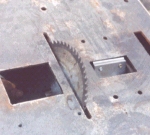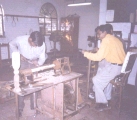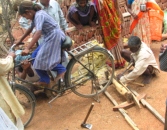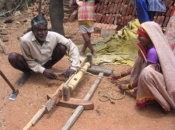|
Technology for the
Rural Carpenters
Suvankar Bose sbose@devalt.org
Bundelkhand is one of the most backward regions in the country. Even
today traditional knowledge holds a key position in the lives of the people in this part. Carpentry is still a major source of
livelihood for many households. However despite the fact that there is a
great demand for wood based products like cots, chairs, tables etc, the
carpenters are not able to earn a substantial amount of income. The
primary reason for this is the high cost of production, which is the
result of a higher power cost or cost of generators. There is also the
problem of power shortage in the region. Most carpenters work on a
mechanized system. But due to electricity shortage, they are not able to
produce efficiently. As an alternative some carpenters use diesel
generators for production, which increase the production cost.
Development Alternatives (DA), an organization with sustainable
livelihood as a mandate, decided to come up with a solution for the
carpenters in the region, which is cost effective and carpenter
friendly. This is the place where Ramesh Prasad Vishwakarma a rural
carpenter is trying to generate livelihood through his carpentry skills
using small manual devices. The machine he is using is still in the
crude form and carries out only one function i.e. lathe.
lives of the people in this part. Carpentry is still a major source of
livelihood for many households. However despite the fact that there is a
great demand for wood based products like cots, chairs, tables etc, the
carpenters are not able to earn a substantial amount of income. The
primary reason for this is the high cost of production, which is the
result of a higher power cost or cost of generators. There is also the
problem of power shortage in the region. Most carpenters work on a
mechanized system. But due to electricity shortage, they are not able to
produce efficiently. As an alternative some carpenters use diesel
generators for production, which increase the production cost.
Development Alternatives (DA), an organization with sustainable
livelihood as a mandate, decided to come up with a solution for the
carpenters in the region, which is cost effective and carpenter
friendly. This is the place where Ramesh Prasad Vishwakarma a rural
carpenter is trying to generate livelihood through his carpentry skills
using small manual devices. The machine he is using is still in the
crude form and carries out only one function i.e. lathe.
Design and Evolution
A
design team from DA interacted with Ramesh. The first thing that the DA
team decided to do was to re-engineer the entire concept. The re-engineering process was a tedious one with a lot of
obstacles being faced by the team. However, the DA team designed a
compact and efficient workstation, with multiple advantages for a
concept. The re-engineering process was a tedious one with a lot of
obstacles being faced by the team. However, the DA team designed a
compact and efficient workstation, with multiple advantages for a carpenter, which was cost effective and with greater productivity. The
biggest advantage this workstation gives to the carpenter is that it is
manually powered. Through this manually powered workstation, a carpenter
can easily carry out all the activities required for manufacturing wood
products. Four different operations like sawing, planning, turning and
profiling have been integrated in this compact workstation. Earlier all
these jobs were done separately and thus a lot of time and cost were
involved. With the carpentry workstation designed by DA, it has become
easy for carpenters to work more efficiently, produce more in less time.
The products of this workstation are also of a higher quality than the
products made earlier with the traditional process.
carpenter, which was cost effective and with greater productivity. The
biggest advantage this workstation gives to the carpenter is that it is
manually powered. Through this manually powered workstation, a carpenter
can easily carry out all the activities required for manufacturing wood
products. Four different operations like sawing, planning, turning and
profiling have been integrated in this compact workstation. Earlier all
these jobs were done separately and thus a lot of time and cost were
involved. With the carpentry workstation designed by DA, it has become
easy for carpenters to work more efficiently, produce more in less time.
The products of this workstation are also of a higher quality than the
products made earlier with the traditional process.
Brief Production
Process
 For
the production of different products like cots, chairs, tables etc the
raw wood requires about four different operations which can be easily
operate in the Manual Carpenter workstation. The four For
the production of different products like cots, chairs, tables etc the
raw wood requires about four different operations which can be easily
operate in the Manual Carpenter workstation. The four different operations are as follows:
different operations are as follows:
Sawing: This operation is required for parting off
the wood blank. In the MCW, by fitting the carbide tipped multi teeth
sawing cutter on the secondary shaft can part off the wooden piece.
Planing:
This operation is required for sizing and
improving surface finish of the wood blank. In the
 MCW,
by fitting the dismantled bladed multi teeth planing cutter on the
secondary shaft can surfacing and sizing the wooden piece. MCW,
by fitting the dismantled bladed multi teeth planing cutter on the
secondary shaft can surfacing and sizing the wooden piece.
Turning:
This operation is required for turning the
wood blank through which the rectangular or irregular wooden pieces turn into cylindrical type surface. In the MCW, the
operation can be done by assembling the head stock and the tail stock.
The head stock will be linked for the transmission of power.
wooden pieces turn into cylindrical type surface. In the MCW, the
operation can be done by assembling the head stock and the tail stock.
The head stock will be linked for the transmission of power.
Profiling: This operation is required for cutting
different profile for decoration purposes. In the MCW, this operation
can be done by assembling the Jigsaw machine and linked with the
secondary shaft for the transmission of power.
Advantages
The advantages of the Manual Powered Carpentry workstation are:
Ø
No
need for electric power in manufacturing.
Ø
Increasing economic growth and increase in purchase power
Ø
Greater demand for wood based products.
Ø
Time
saving method of production.
Ø
Cost
effective due to use of local material, fewer labour and speed of
manufacture
|
Frequently Asked Questions |
|
What is the
production capacity?
The average
production capacity of a unit typically ranges near about 2 chairs
per day; one table in about 3 days. So the annual capacity comes to
nearly about 12000 chairs and 1500 tables. For processing the wooden
blank in the Manual Carpentry workstation into desired profile a
skilled operator is required with an unskilled person for paddling.
How much land
required?
There is no
requirement of land for this particular enterprise as such. However,
the entrepreneur needs to take a small room of the size of 1000 sq.
ft or so to install the workstation and to store the products.
Where is the
market?
In the rural
areas where electric power is not available or huge power failure,
there the carpenters, who are struggling for lowering the cost of
manufacturing, can use this Manual Powered Carpentry workstation for
generating their livelihoods.
How much to
invest?
Total project cost is Rs 0.5 Lac
for setting up one workstation producing 2 chairs per day.
The project cost does not include price of land and building.
Adding more machines can increase the capacity based on the demand.
Who should
invest?
This technology
is ideally suited for small entrepreneurs / carpenters manufacturing
wood products like chairs, tables, cots etc. Carpenters using
traditional technologies can diversify into production methods of
the manual powered carpentry workstation. This workstation also
saves a lot of production cost by removing the cost of power from
the equation. This results in greater power saving as well. |
.
q
Back to Contents |
 lives of the people in this part. Carpentry is still a major source of
livelihood for many households. However despite the fact that there is a
great demand for wood based products like cots, chairs, tables etc, the
carpenters are not able to earn a substantial amount of income. The
primary reason for this is the high cost of production, which is the
result of a higher power cost or cost of generators. There is also the
problem of power shortage in the region. Most carpenters work on a
mechanized system. But due to electricity shortage, they are not able to
produce efficiently. As an alternative some carpenters use diesel
generators for production, which increase the production cost.
Development Alternatives (DA), an organization with sustainable
livelihood as a mandate, decided to come up with a solution for the
carpenters in the region, which is cost effective and carpenter
friendly. This is the place where Ramesh Prasad Vishwakarma a rural
carpenter is trying to generate livelihood through his carpentry skills
using small manual devices. The machine he is using is still in the
crude form and carries out only one function i.e. lathe.
lives of the people in this part. Carpentry is still a major source of
livelihood for many households. However despite the fact that there is a
great demand for wood based products like cots, chairs, tables etc, the
carpenters are not able to earn a substantial amount of income. The
primary reason for this is the high cost of production, which is the
result of a higher power cost or cost of generators. There is also the
problem of power shortage in the region. Most carpenters work on a
mechanized system. But due to electricity shortage, they are not able to
produce efficiently. As an alternative some carpenters use diesel
generators for production, which increase the production cost.
Development Alternatives (DA), an organization with sustainable
livelihood as a mandate, decided to come up with a solution for the
carpenters in the region, which is cost effective and carpenter
friendly. This is the place where Ramesh Prasad Vishwakarma a rural
carpenter is trying to generate livelihood through his carpentry skills
using small manual devices. The machine he is using is still in the
crude form and carries out only one function i.e. lathe.  concept. The re-engineering process was a tedious one with a lot of
obstacles being faced by the team. However, the DA team designed a
compact and efficient workstation, with multiple advantages for a
concept. The re-engineering process was a tedious one with a lot of
obstacles being faced by the team. However, the DA team designed a
compact and efficient workstation, with multiple advantages for a carpenter, which was cost effective and with greater productivity. The
biggest advantage this workstation gives to the carpenter is that it is
manually powered. Through this manually powered workstation, a carpenter
can easily carry out all the activities required for manufacturing wood
products. Four different operations like sawing, planning, turning and
profiling have been integrated in this compact workstation. Earlier all
these jobs were done separately and thus a lot of time and cost were
involved. With the carpentry workstation designed by DA, it has become
easy for carpenters to work more efficiently, produce more in less time.
The products of this workstation are also of a higher quality than the
products made earlier with the traditional process.
carpenter, which was cost effective and with greater productivity. The
biggest advantage this workstation gives to the carpenter is that it is
manually powered. Through this manually powered workstation, a carpenter
can easily carry out all the activities required for manufacturing wood
products. Four different operations like sawing, planning, turning and
profiling have been integrated in this compact workstation. Earlier all
these jobs were done separately and thus a lot of time and cost were
involved. With the carpentry workstation designed by DA, it has become
easy for carpenters to work more efficiently, produce more in less time.
The products of this workstation are also of a higher quality than the
products made earlier with the traditional process.  For
the production of different products like cots, chairs, tables etc the
raw wood requires about four different operations which can be easily
operate in the Manual Carpenter workstation. The four
For
the production of different products like cots, chairs, tables etc the
raw wood requires about four different operations which can be easily
operate in the Manual Carpenter workstation. The four different operations are as follows:
different operations are as follows: MCW,
by fitting the dismantled bladed multi teeth planing cutter on the
secondary shaft can surfacing and sizing the wooden piece.
MCW,
by fitting the dismantled bladed multi teeth planing cutter on the
secondary shaft can surfacing and sizing the wooden piece.
 wooden pieces turn into cylindrical type surface. In the MCW, the
operation can be done by assembling the head stock and the tail stock.
The head stock will be linked for the transmission of power.
wooden pieces turn into cylindrical type surface. In the MCW, the
operation can be done by assembling the head stock and the tail stock.
The head stock will be linked for the transmission of power.